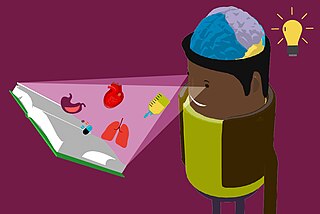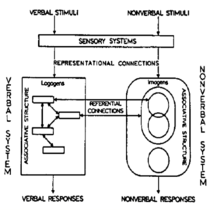Long-term memory (LTM) is the stage of the Atkinson–Shiffrin memory model in which informative knowledge is held indefinitely. It is defined in contrast to sensory memory, the initial stage, and short-term or working memory, the second stage, which persists for about 18 to 30 seconds. LTM is grouped into two categories known as explicit memory and implicit memory. Explicit memory is broken down into episodic and semantic memory, while implicit memory includes procedural memory and emotional conditioning.
Source amnesia is the inability to remember where, when or how previously learned information has been acquired, while retaining the factual knowledge. This branch of amnesia is associated with the malfunctioning of one's explicit memory. It is likely that the disconnect between having the knowledge and remembering the context in which the knowledge was acquired is due to a dissociation between semantic and episodic memory – an individual retains the semantic knowledge, but lacks the episodic knowledge to indicate the context in which the knowledge was gained.
The spacing effect demonstrates that learning is more effective when study sessions are spaced out. This effect shows that more information is encoded into long-term memory by spaced study sessions, also known as spaced repetition or spaced presentation, than by massed presentation ("cramming").
Serial-position effect is the tendency of a person to recall the first and last items in a series best, and the middle items worst. The term was coined by Hermann Ebbinghaus through studies he performed on himself, and refers to the finding that recall accuracy varies as a function of an item's position within a study list. When asked to recall a list of items in any order, people tend to begin recall with the end of the list, recalling those items best. Among earlier list items, the first few items are recalled more frequently than the middle items.

Baddeley's model of working memory is a model of human memory proposed by Alan Baddeley and Graham Hitch in 1974, in an attempt to present a more accurate model of primary memory. Working memory splits primary memory into multiple components, rather than considering it to be a single, unified construct.

Dual-coding theory is a theory of cognition that suggests that the mind processes information along two different channels; verbal and nonverbal. It was hypothesized by Allan Paivio of the University of Western Ontario in 1971. In developing this theory, Paivio used the idea that the formation of mental imagery aids learning through the picture superiority effect.
The Levels of Processing model, created by Fergus I. M. Craik and Robert S. Lockhart in 1972, describes memory recall of stimuli as a function of the depth of mental processing. More analysis produce more elaborate and stronger memory than lower levels of processing. Depth of processing falls on a shallow to deep continuum. Shallow processing leads to a fragile memory trace that is susceptible to rapid decay. Conversely, deep processing results in a more durable memory trace. There are three levels of processing in this model. Structural processing, or visual, is when we remember only the physical quality of the word E.g how the word is spelled and how letters look. Phonemic processing includes remembering the word by the way it sounds. E.G the word tall rhymes with fall. Lastly, we have semantic processing in which we encode the meaning of the word with another word that is similar or has similar meaning. Once the word is perceived, the brain allows for a deeper processing.
Repetition blindness (RB) is a phenomenon observed in rapid serial visual presentation. People are sometimes poor at recognizing when things happen twice. Repetition blindness is the failure to recognize a second happening of a visual display. The two displays are shown sequentially, possibly with other stimuli displays in between. Each display is only shortly shown, usually for about 150 milliseconds. If stimuli are shown in between, RB can occur in a time interval up to 600 milliseconds. Without other stimuli displayed in between the two repeated stimuli, RB only lasts about 250 milliseconds. Repetition blindness tasks usually are words in lists and in sentences. They are called phonologically similar items. There are also pictures, and words that include pictures. An example of this is a picture of the sun and the word sun. The most popular task used to examine repetition blindness is to show words one after another on a screen fast in which participants must recall the words that they saw. This task is known as the rapid serial visual presentation (RSVP). Repetition blindness is present if missing the second word creates an inaccurate sentence. An example of this is "When she spilled the ink there was ink all over.” An RSVP sequence participants will recall seeing "When she spilled the ink there was all over." However, they are missing the second occurrence of "ink". This finding supports that people are "blind" for the second occurrence of a repetitive item in an RSVP series. For example, a subject's chances of correctly reporting both appearances of the word "cat" in the RSVP stream "dog mouse cat elephant cat snake" are lower than their chances of reporting the third and fifth words in the stream "dog mouse cat elephant pig snake".
Memory has the ability to encode, store and recall information. Memories give an organism the capability to learn and adapt from previous experiences as well as build relationships. Encoding allows a perceived item of use or interest to be converted into a construct that can be stored within the brain and recalled later from long-term memory. Working memory stores information for immediate use or manipulation, which is aided through hooking onto previously archived items already present in the long-term memory of an individual.
The generation effect is a phenomenon whereby information is better remembered if it is generated from one's own mind rather than simply read. Researchers have struggled to account for why the generated information is better recalled than read information, but no single explanation has been sufficient to explain everything.
Artificial grammar learning (AGL) is a paradigm of study within cognitive psychology and linguistics. Its goal is to investigate the processes that underlie human language learning by testing subjects' ability to learn a made-up grammar in a laboratory setting. It was developed to evaluate the processes of human language learning but has also been utilized to study implicit learning in a more general sense. The area of interest is typically the subjects' ability to detect patterns and statistical regularities during a training phase and then use their new knowledge of those patterns in a testing phase. The testing phase can either use the symbols or sounds used in the training phase or transfer the patterns to another set of symbols or sounds as surface structure.
Allan Urho Paivio was a professor of psychology at the University of Western Ontario and former bodybuilder. He earned his Ph.D. from McGill University in 1959 and taught at the University of Western Ontario from 1963 until his retirement.
Priming is the idea that exposure to one stimulus may influence a response to a subsequent stimulus, without conscious guidance or intention. The priming effect refers to the positive or negative effect of a rapidly presented stimulus on the processing of a second stimulus that appears shortly after. Generally speaking, the generation of priming effect depends on the existence of some positive or negative relationship between priming and target stimuli. For example, the word nurse might be recognized more quickly following the word doctor than following the word bread. Priming can be perceptual, associative, repetitive, positive, negative, affective, semantic, or conceptual. Priming effects involve word recognition, semantic processing, attention, unconscious processing, and many other issues, and are related to differences in various writing systems. Onset of priming effects can be almost instantaneous.
Recognition memory, a subcategory of explicit memory, is the ability to recognize previously encountered events, objects, or people. When the previously experienced event is reexperienced, this environmental content is matched to stored memory representations, eliciting matching signals. As first established by psychology experiments in the 1970s, recognition memory for pictures is quite remarkable: humans can remember thousands of images at high accuracy after seeing each only once and only for a few seconds.
In psychology, implicit memory is one of the two main types of long-term human memory. It is acquired and used unconsciously, and can affect thoughts and behaviours. One of its most common forms is procedural memory, which allows people to perform certain tasks without conscious awareness of these previous experiences; for example, remembering how to tie one's shoes or ride a bicycle without consciously thinking about those activities.
The encoding specificity principle is the general principle that matching the encoding contexts of information at recall assists in the retrieval of episodic memories. It provides a framework for understanding how the conditions present while encoding information relate to memory and recall of that information.
Retrieval-induced forgetting (RIF) is a memory phenomenon where remembering causes forgetting of other information in memory. The phenomenon was first demonstrated in 1994, although the concept of RIF has been previously discussed in the context of retrieval inhibition.

Bilingualism is the regular use of two fluent languages, and bilinguals are those individuals who need and use two languages in their everyday lives. A person's bilingual memories are heavily dependent on the person's fluency, the age the second language was acquired, and high language proficiency to both languages. High proficiency provides mental flexibility across all domains of thought and forces them to adopt strategies that accelerate cognitive development. People who are bilingual integrate and organize the information of two languages, which creates advantages in terms of many cognitive abilities, such as intelligence, creativity, analogical reasoning, classification skills, problem solving, learning strategies, and thinking flexibility.
Sex differences in cognition are widely studied in the current scientific literature. Biological and genetic differences in combination with environment and culture have resulted in the cognitive differences among males and females. Among biological factors, hormones such as testosterone and estrogen may play some role mediating these differences. Among differences of diverse mental and cognitive abilities, the largest or most well known are those relating to spatial abilities, social cognition and verbal skills and abilities.
Cyma Kathryn Van Petten is an American cognitive neuroscientist known for electrophysiological studies of language, memory, and cognition. She is Professor of Psychology at the State University of New York at Binghamton where she directs the Event-Related Potential Lab. Van Petten was recipient of the Early Career Award from the Society for Psychophysiological Research in 1994.





